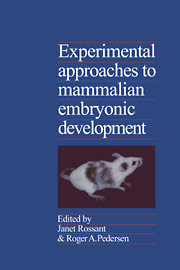Book contents
- Frontmatter
- Contents
- Preface
- Contributors
- Cellular aspects
- Molecular and biochemical aspects
- 6 Regulation of gene expression during mammalian spermatogenesis
- 7 Molecular aspects of mammalian oocyte growth and maturation
- 8 Utilization of genetic information in the preimplantation mouse embryo
- 9 Metabolic aspects of the physiology of the preimplantation embryo
- 10 Role of cell surface molecules in early mammalian development
- 11 Cell-lineage-specific gene expression in development
- 12 X-chromosome regulation in oogenesis and early mammalian development
- Toward a genetic understanding of development
- Index
9 - Metabolic aspects of the physiology of the preimplantation embryo
from Molecular and biochemical aspects
Published online by Cambridge University Press: 31 March 2010
- Frontmatter
- Contents
- Preface
- Contributors
- Cellular aspects
- Molecular and biochemical aspects
- 6 Regulation of gene expression during mammalian spermatogenesis
- 7 Molecular aspects of mammalian oocyte growth and maturation
- 8 Utilization of genetic information in the preimplantation mouse embryo
- 9 Metabolic aspects of the physiology of the preimplantation embryo
- 10 Role of cell surface molecules in early mammalian development
- 11 Cell-lineage-specific gene expression in development
- 12 X-chromosome regulation in oogenesis and early mammalian development
- Toward a genetic understanding of development
- Index
Summary
Introduction
Fertilization and preimplantation development of eutherian mammals occur in the oviduct and uterine lumen, when the embryo is often described as a closed system. Largely successful attempts to devise a totally defined medium in which normal preimplantation development may occur in vitro have reinforced this concept. However, the mammalian embryo must communicate with the maternal physiology via the fluid of the reproductive tract. It is clear that this channel is used in the case of nutrients, which has been demonstrated by studies of embryonic metabolism in vitro.
The early mammalian embryo has several advantages for the study of metabolism. Development of several species can occur in a completely defined medium in vitro (for a review, see Mastroianni and Biggers 1981), enabling definition of the effects of environmental perturbations on the embryo. Although the tissue mass is small, with many techniques it is now possible to assay one or a few embryos, diminishing animal and chemical requirements and facilitating rapid manipulation and assay of labile compounds. Thus, it is feasible in many cases to obtain estimates of metabolite levels and their embryonic and maternal variations. This should permit further studies of the effects of nutritional and environmental manipulation of the mother's environment and toxicological insults on embryonic and reproductive tract metabolism. Finally, it is possible to study the metabolic bases and ramifications of the first differentiations that occur during this time, as discussed in other chapters in this volume.
There is wide species diversity in developmental patterns from fertilization to implantation. Except where comparative data are illuminating or innovative, this review deals predominantly with the mouse, for which most detailed information exists.
- Type
- Chapter
- Information
- Experimental Approaches to Mammalian Embryonic Development , pp. 267 - 292Publisher: Cambridge University PressPrint publication year: 1987
- 1
- Cited by



